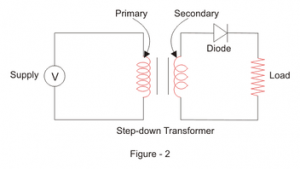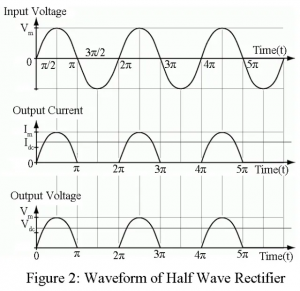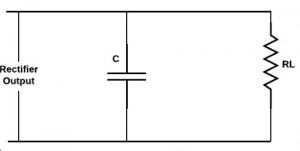Working of Half Wave Rectifier
In order to convert AC Voltage and DC Voltage, the half wave rectifier is actively employed. And it is important for students to understand how the half wave rectifier works, and what difference it makes in a circuit, especially in its usage in finding out various quantities. However, if you are learning the topic of half wave rectifier working for the first time, you might find it hard to understand the principle more clearly. This is why we are going to provide a detailed guide on the half wave rectifier working, in this article.
What is a Half Wave Rectifier?
As stated above, the half wave rectifier is equipment used in the circuit board, mainly to convert AC Voltage into DC Voltage. And not just that, it is said to be one of the simplest types of rectifiers, as it only needs one diode in order to make the half wave rectifier. Moreover, depending on the type of appliance, or the application, the AC voltage is converted to DC Voltage and vice versa. A half wave rectifier allows only one-half cycle of an AC voltage waveform to pass as it blocks the other half cycle. This is a primary aspect to learn as part of the half wave rectifier working.
The half wave rectifier consists of three main components, such as,
- Diode
- Resistive Load
- Transformer
Half Wave Rectifier Circuit Diagram
The Half wave rectifier diagram is shown below,

Working of Half Wave Rectifier
Now that we have covered the basics of a half-wave rectifier waveform, let us now discuss how the half wave rectifier works, in order to convert AC voltage into DC voltage.
- As Shown in Half wave rectifier diagram, firstly, a high voltage is applied to the primary side of the step-down transformer. Now a secondary low voltage is applied to the diode.
- Moreover, based on the positive half cycle and a negative half cycle of AC Voltage, the diode is changed from forward-biased to reverse-biased.
- During the positive half cycle of the AC voltage, the diode is in forward bias mode and the current flows through it. In the case of the negative half cycle of the AC voltage, the diode is in reverse bias where the current flow is blocked.
- After this, the Final voltage observed from the circuit is the DC voltage.
Half Wave Rectifier Formulae

Ripple Factor of Half Wave Rectifier
\(\gamma = \sqrt{ (\frac{ V_{rms} }{ V_{dc} }) ^{2} } -1\)
Generally, the value of the Half Wave rectifier is 1.21.
RMS Value of Half Wave Rectifier
\(I_{rms} = \frac{ I_{m} }{2}\)
Efficiency of Half Wave Rectifier
\(\eta = \frac{ P_{DC} }{ P_{AC} }\)
Form Factor of Half Wave Rectifier
The form factor is defined as the ratio of RMS and Average Value.
\( \eta = \frac{RMS value}{Average Value}\)
Half wave rectifier Capacitor Filter
Filters are basically components that are used to convert pulsating DC waveforms into DC waveforms that are constant. This is attained through suppressing the DC ripples lying in the waveform.
Theoretically, half-wave rectifiers can be without filters, but in practice, this cannot be put to use. We must note that the DC equipment needs a constant waveform, and this pulsating waveform should be smoothened out so that it can be put to use for practical real-life purposes.
Therefore, we employ those half wave rectifiers that are with a filter. A capacitor can be such a filter – but in real cases, a half-wave rectifier with a capacitor filter is the most used one.

Working of half wave rectifier capacitor
As shown in the above half wave rectifier circuit diagram with capacitive filter, Let us consider the process of rectification where generated output does not usually result in the pure DC form and ripples in the output are spotted. This is a crucial aspect in the working of the half wave rectifier with a capacitor filter. These ripples are nothing more than the undesirable AC parts that are seen in the output DC. The efficiency of the circuit is thus influenced in a negative way. By connecting the capacitor filter across the load, the circuit’s unwanted frequencies can be filtered. The capacitors are kept after the voltage regulators, to smoothen the output that is generated, thus confirming the advantage to the half full-wave rectifier circuit.
Please note that a load resistor is present in the half as well as full-wave circuits and is meant to remove the ripples from the output DC and this filter is placed along with the load. This forms the basic objective to power half wave rectifiers with capacitor filters.
Now the voltage passes through the capacitor’s connection terminals and eventually gets charged sufficiently with power supplied to the load. The capacitor is expected to charge substantially till it attains the maximum value of the applied input wave. The voltage of the rectifier gets degraded with the capacitor getting discharged after it reaches the maximum
The degradation in the wave is not done and will just reduce but the continuity is ensured due to the occurrence of the subsequent peak. This is seen as a continuous development and crucial in the working of the half wave rectifier with a capacitor filter.
Advantages and Disadvantages of Half Wave Rectifier
There are many advantages and disadvantages of the Half Wave Rectifier, which we are going to explain in detail below.
Pros of Half Wave Rectifier
- They are generally used in various signal peak applications.
- They are also used in rectification applications.
- Half Wave Rectifier can be employed in signal demodulation actively.
- Moreover, the Half Wave rectifier is made of simple components and is easy to use.
Cons of Half Wave Rectifier
- Power Loss is a common disadvantage of the Half Wave Rectifier.
- Most of the time, the output observed in the Half Wave Rectifier has multiple types of ripples.
- The output voltage observed in this Half Wave rectifier is low.
Conclusion
There are many other complex topics and chapters in Physics, which might be a bit hard to understand. If you are one of these people it is better for you to take part or join the Online Home Tutor Programs. One such program is offered by the Tutoroot platform, which offers various amazing benefits such as cost-effective prices, access to the best educational guides, expert staff, doubt-clearing sessions, and many more.
Frequently Asked Questions
What is the ripple factor of half wave rectifier?
The unwanted AC component available in the Half Wave rectifier after converting AC Voltage to DC Voltage is said to be the ripple factor, which is considered to be 1.21 in mathematical terms.
What is a half wave rectifier?
As explained in the above article, it is a rectifier component in a circuit, that is generally used to convert AC into DC Voltage by managing the negative and positive half cycles in the said circuit.
What is half wave rectifier with a DC source?
A half-wave rectifier with DC source converts the AC signal to a DC, by sending either negative or positive half-cycle of the waveform, besides ensuring the other one is blocked.
What is the Ripple Factor of Half Wave Rectifier?
The ripple factor of half half-wave rectifier is the one that determines how effectively the halfwave rectifier can get the AC voltage transformed into DC voltage. The ripple factor of a halfwave rectifier is 1.21.
What is Half Wave Rectifier with a Capacitive Filter?
A capacitor filter will help minimize the ripple voltage. The most important property of the capacitor is to enable the passage of the AC signal but at the same time, block the DC signal, thus becoming the primary feature of the half wave rectifier with capacitor filter
